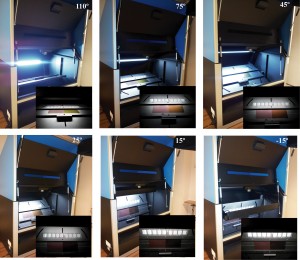WP Leader: INRIM
WP5: Visual perception
The aim of this workpackage is to measure the visual attributes of materials through subjective responses, providing a connection between the visual appearance, evaluation and metrological characterisation of a material. The visual attributes, gloss, goniochromatism, fluorescence, sparkle and graininess, can be easily recognised, categorised and scaled by subjects. Whilst some of these appearances have a traditional metrological definition, new material appearances are not well described in metrological terms, or even by subjective perception.
The objectives of this workpackage are:
- To provide a synthesis between the visual attributes and their metrological characterisation;
- To build reference systems and improve the parametric definitions of visual attributes;
- To correlate visual intensity response stimuli to material characteristics and environment attributes.
The approach will be focused on soft metrology (i.e. metrological definition and characterisation of quantities correlated to human response) using artefacts that have been characterised using the advanced definitions developed in this JRP.
Task 5.1: Definition of artefacts for investigation
Start: August 2014, End: September 2014
The aim of this task is to define the artefacts and their characteristics that are to be used in the subjective tests. In order to perform subjective tests on the perception of visual attributes, it is necessary to choose artefacts, different in their visual attributes that have metrological characteristics that are very well defined.
Description of work: In this task several coloured artefacts, different in gloss, fluorescence and texture will be considered. Artefacts will be chosen according to their visual interest and the metrological characteristics coming from measurements made in WP1, WP2, and WP3.
Background: For gloss, we know that the sensation depends of the shape of the specular peak. If the peak is sharp, the sample looks glossy, if the peak is smooth, the sample looks matte. The height of the specular peak according to the background is also important. The shape of the specular peak depends upon the roughness and the refractive index of the material.
For goniochromatism we know that the colour variation depends on geometrical behaviour of illumination and observation. Usually such colour variations depend from special effect pigments producing interference effects.
Task 5.2: Definition of perception scale of visual attributes for gloss
Start: October 2014, End: April 2016
The aim of this task is to investigate reference systems for defining intensity scales of gloss visual attributes stimuli.
Description of activities:
- CNAM with support from REG(KU Leuven) will derive and write a report on the visual scales of different attributes of gloss (overall gloss, brightness of the specular highlight, haze, DOI, and contrast gloss) using the selected artefacts for gloss, a psychophysical protocol and a light booth dedicated to gloss appearance evaluation based on recommendations in ASTM D4490-9090 (“Standard Test Method for Visual Evaluation of Gloss Differences Between Surfaces of Similar Appearance”) .
- CNAM will derive a gloss visual scale using the selected artefacts for gloss , a psychophysical protocol and a light booth dedicated to gloss appearance evaluation based on recommendations in ASTM D4490-9090 .
- CNAM will write a report on the experimental setup and protocol for the visual perception of gloss investigations.
- INRIM, using the artefacts from this WP5 and virtual stimuli from WP4, will perform subjective experiments to investigate perception threshold of the visual sensation of gloss.
- INRIM using outputs of the visual experiments will select a reduced set of the artefacts issues from WP2 to be representative of the different perceptual aspects of visual sensation of gloss. A minimum of 5 artefacts will be considered to establish a reference set.
Task 5.3: Definition of perception scale of visual attributes for colour and sparkle/graininess
Start: September 2014, End: February 2016
The aim of this task is to investigate reference systems for defining descriptors and scales for goniochromatism and sparkle/graininess visual attributes stimuli.
Description of work: Using the artefacts defined and selected in task 5.1 and virtual stimuli, subjective experiments will be carried out in order to investigate perception scales and threshold of visual attributes.
Task 5.4: Influences of the spectral environment on the perception of the visual attributes
Start: August 2014, End: February 2016
The aim of this task is to investigate how visual environmental conditions (i.e. level of illuminance, level ofadaptation, spectral composition of light) affect the perception of visual attributes.
Background: For Solid State Lighting (SSL) robust predictive methods for human perception of SSL products are not available. In this task the results of JRP09 ENG05 “Metrology of Solid State Lighting” will be also used in order to investigate the effects of SSL on gloss, goniochromatism and sparkle.
Description of work: Using the artefacts defined in task 5.1 several subjective experiments will be carried out in order to investigate the influence of environment attributes on visual perception.
Task 5.5: Influences of geometrical environment on the perception of the visual attributes
Start: October 2015, End: March 2016
The aim of this task is to investigate how geometrical attributes of viewing conditions and objects (i.e. angle of observation, viewing distance and object geometry) affect the perception of visual attributes.
Description of work: Using a part of the artefacts defined in Task 5.1, convex/concave samples and virtual stimuli, several subjective experiments will be carried out in order to investigate the influence of geometrical attributes on visual perception.
Task 5.6: Procedures and guidelines
Start: February 2016, End: July 2016
The aim of this task is to develop procedures and provide guidelines for standard test methods for visual evaluation of glossy, goniochromatic, sparkling and grainy samples, in order to build a common base essential for comparing results issued from visual evaluation.
